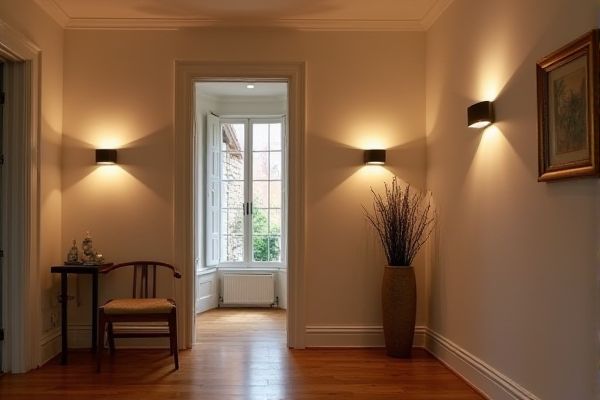
Overhead lighting provides broad, even illumination suitable for general tasks, while wall sconces add focused, ambient light that enhances room atmosphere and design. Discover which lighting choice best suits Your space by exploring the advantages of both options in the rest of the article.
Table of Comparison
| Feature | Overhead Lighting | Wall Sconces |
|---|---|---|
| Installation | Ceiling-mounted, requires wiring | Wall-mounted, often easier to install |
| Lighting Coverage | Provides broad, general illumination | Offers focused or ambient lighting |
| Design Impact | Central focal point in room | Adds decorative accents and mood lighting |
| Space Utilization | Uses ceiling space, frees floor/wall | Occupies wall space, ideal for limited ceilings |
| Energy Efficiency | Can use energy-efficient bulbs and fixtures | Generally uses lower wattage, efficient for accents |
| Cost | Often higher installation and fixture cost | Typically lower installation cost |
| Application | Ideal for general, task, and ambient lighting | Best for accent, decorative, and supplementary lighting |
Understanding Overhead Lighting and Wall Sconces
Overhead lighting provides broad, ambient illumination essential for general visibility in any room, while wall sconces offer focused, decorative lighting that enhances ambiance and highlights specific areas. Choosing between overhead lighting and wall sconces depends on your space's size, function, and aesthetic needs, as each serves distinct purposes in lighting design. Properly combining these fixtures can create layered lighting that optimizes both functionality and style.
Key Differences Between Overhead Lighting and Wall Sconces
Overhead lighting provides broad, ambient illumination that efficiently brightens an entire room, making it ideal for general visibility and functional tasks. Wall sconces offer localized, softer lighting that enhances ambiance and adds decorative appeal, often serving as accent or supplementary light sources. The key differences lie in their placement, light distribution, and primary purpose--overhead lighting emphasizes overall brightness, while wall sconces focus on mood and architectural highlights.
Aesthetic Impact: Style and Ambiance
Overhead lighting provides uniform illumination that enhances the room's overall brightness, often creating a clean and modern aesthetic. Wall sconces add layered lighting that contributes to a cozy ambiance and offer decorative elements that can complement your interior style. Choosing between the two depends on whether you prioritize broad lighting coverage or accentuated visual appeal in your living space.
Brightness and Light Distribution Comparison
Overhead lighting typically provides uniform brightness and broad light distribution, illuminating entire rooms efficiently. Wall sconces offer localized, softer light that enhances ambiance but may create shadows or uneven lighting without supplementary sources. Choosing between the two depends on the desired brightness level and spatial lighting needs.
Energy Efficiency and Bulb Options
Overhead lighting typically accommodates a wider range of bulb options, including energy-efficient LEDs and CFLs, allowing for customizable brightness and color temperatures that suit various spaces. Wall sconces often use smaller bulbs that can be less energy-efficient but are increasingly compatible with LED technology, reducing power consumption while enhancing ambiance. Choosing the right fixture can optimize your home's energy efficiency by balancing the bulb type and lighting coverage needed.
Room Suitability and Placement Considerations
Overhead lighting provides broad, uniform illumination ideal for large rooms such as kitchens and living areas, ensuring even light distribution from ceiling fixtures centered in the space. Wall sconces work best in smaller areas like hallways, bathrooms, or alongside beds, offering targeted, ambient lighting while enhancing decor and saving floor space. Proper placement of sconces typically involves mounting them at eye level around 60-66 inches from the floor to avoid glare and maximize functional and aesthetic impact.
Installation Complexity and Cost Factors
Overhead lighting typically involves more complex installation, often requiring ceiling wiring, electrical box reinforcement, and possibly professional electrician services, which can increase overall costs. Wall sconces usually have simpler installation processes, especially if mounting on existing wiring or surface-mounted options, making them more cost-effective for updating your space. Your choice directly impacts labor expenses and material needs, influencing the total investment in lighting fixtures.
Maintenance Requirements and Lifespan
Overhead lighting typically requires less frequent cleaning and bulb replacements due to its centralized position and often enclosed fixtures, leading to a longer lifespan with minimal maintenance. Wall sconces, however, may demand more regular dusting and bulb changes since they are more exposed and sometimes use decorative bulbs that burn out faster. Your choice between the two should consider how much maintenance time you can dedicate and the expected durability of the lighting fixtures.
Popular Design Trends for Each Lighting Type
Overhead lighting often features sleek, minimalist fixtures such as flush mounts and pendant lights that cater to contemporary and industrial design trends, providing broad illumination ideal for kitchens and living rooms. Wall sconces embrace vintage and farmhouse aesthetics, with rustic finishes and decorative elements adding ambient, accent lighting to hallways and bedrooms. Your choice between these lighting types can enhance the room's atmosphere by aligning with popular trends that balance functionality and style.
Choosing the Right Lighting Solution for Your Space
Overhead lighting provides broad, even illumination ideal for general visibility in kitchens and living rooms, while wall sconces offer targeted accent lighting to enhance ambiance and highlight architectural features. Selecting the right lighting solution depends on room size, purpose, and design style, with overhead fixtures perfect for task-oriented areas and sconces suited for creating mood or adding decorative appeal. Combining both can balance functionality and aesthetics, ensuring optimal light distribution and atmosphere tailored to your space.
 homyna.com
homyna.com